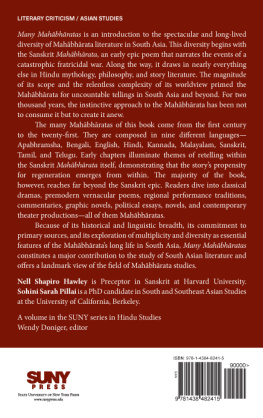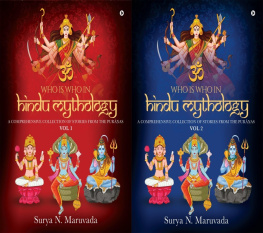Many Mahbhratas
We dedicate this volume to the memory of our beloved mentor,
Anne Elizabeth Monius
SUNY series in Hindu Studies
Wendy Doniger, editor
Illustrations
Note on Transliteration
Throughout this volume, we use an italicized Mahbhrata to refer to the Sanskrit epic specifically. When referring to works outside of the Sanskrit Mahbhrata that take up its name, structure, narrative(s), and characters, we use an unitalicized Mahbhrata. We also use an unitalicized Mahbhrata to refer to the concept of the tradition as a whole.
This book examines Mahbhratas in a number of different South Asian languages. To make things easier for our readers, the names of characters are represented according to how their names appear in the Sanskrit Mahbhrata and transliterated according to the International Alphabet of Sanskrit Transliteration (IAST). For example, the name of the shared wife of the Pavas appears as Draupad, not Draupadi (as it would be written without diacritics) or Tiraupati (as it would be written according to standard Tamil transliteration practices). Other characters (including characters who are clearly based on characters from the Sanskrit epic, but do not actually share their names) are represented in our essays according to how their names appear in the primary sources, with appropriate transliteration.
The names of compositions and premodern authors have been transliterated according to the standard practices for their language of origin (for example: Villiputtrs Tamil Pratam). In the case of the names of languages, modern South Asian authors, and contemporary South Asian communities, diacritics have been omitted (Kannada, Rabindranath Tagore, Nishada, etc.). We do not use italics for the Sanskrit words dharma or karma as they have become common in many European languages.
Foreword
P AULA R ICHMAN
Why would a scholar of the Rmyaa tradition agree to write a foreword for a volume about diverse tellings of the Mahbhrata tradition, a work that she labeled the other epic decades ago when she studied it in a graduate seminar?
Yet rather than perceiving the two as irreconcilable, let us consider that encountering the Mahbhrata and Rmyaa narrative traditions in While the Rmyaa serves as a narrative of ideals, the Mahbhrata presents a more realistic reflection of how elites wield power and resort to violence. Today, when political leaders in many countries propagate untruths, scapegoat minorities, and engage in corruption of unprecedented magnitude, edification from narratives that have stood the test of time should be welcomed. They provide examples of what fruit befell the actions of others in the past, but because they continue to be retold and reinterpreted, they also allow us to ask new questions.
Before moving to some of the riches of the volume you are reading, permit me to comment on a little-known retelling of a Mahbhrata episode that serves as an example of how a new telling can prompt reflection on a timely issuein this case, how society perceives transgender individuals. Muthal Naidoo, a South African of Indian descent, wrote Flight from the Mahabharath in the early 1990s. The play represents an effort to dramatize the dangers that ensue when an entrenched class divides other humans into essentialized groups in order to rob them of agency. criticism the starting point of her story, thereby broadening the scope and depth of the Mahbhrata tradition.
Naidoos play opens as Draupad leads a group of women out of the Epic. No longer do they intend to remain in a narrative that has locked them into gender roles that impel them to bear and raise sons but deprive them of the ability to prevent their boys from dying in wars provoked by their fathers. Fleeing the Epic, they enter the genre of drama. Upon arrival, they quickly change from saris to less constrictive garb and celebrate their ability as women to take control over their own lives. Yet challenges to their self-contained new world soon emerge. Two men dressed as women appear and ask to join this new created place: Bhanna (Arjuna in makeup, jewelry, and a dancers clothing, with a grammatically female name) and ikhain (Princess Amb, reborn male in order to slay Bhma). The two insist that the Epic has victimized not only Draupad and her women companions but them as well. They demonstrate that they have rejected masculinity by pointing out that they have vowed henceforth never to shed blood. After arguing about whether to admit the two to the world that the women have worked so hard to create, the women finally decide to let the two join them.
Immediately another dilemma arises. Since epic plots rest on conflict that leads to war, how can the cast of the drama reject Epic patriarchy, which glorifies violence? Subhadr asks whether removing violence will drain an epic of its excitement. Bhanna responds by offering to teach the women martial arts so as to free them from depending on men for protection. Agreeing to learn self-defense, the women adopt the proposal of Rdh (Karas foster mother) to rid their drama of heroes and villains, to avoid complicity in the glorification of bloodshed. The dramas director, Draupad, now announces that they can free themselves from Epic constraints by retelling their stories such that they align with the new identities they have embraced. Draupad plans to alter her story so that her sole husband is Arjuna, airbrushing away her other fourbut ikhain quickly jumps in and changes Draupads svayavara (bride-groom choice ceremony) into a dance competition to showcase Bhannas skills. Draupad now realizes that the womens stories are interdependent; changing one means changing others. Indeed, Bhanna eagerly rejects his (or her) Epic roles as Arjuna the warrior and Arjuna the husband, but Bhannas plan means that Draupad cannot enact her own. Since Bhanna left the Epic in order to escape both warfare and wife, he (or she) threatens to withdraw from the drama. Immediately, Draupad withdraws, too.
The play continues without them. Whats more, the Mahbhratas male roles are now played by women in disguise. During the scene in the assembly hall, the actress playing Duryodhana pulls off Draupads saribut Draupad, having left the scene, is now played by ikhain. Although many tellings of this episode show Ka saving Draupad from humiliation by lengthening her sari indefinitely, no divine intervention occurs here. Instead, Duryodhana strips off her sari and attempts to shame her by placing her on his lap. When ikhains wig falls off, Duryodhana discovers that she is a man, and flees in homophobic terror. By the next scene, Bhanna has rejoined the drama and narrates Arjunas story: male gender constructs, Bhanna says, were forced on Arjuna since boyhood; he escaped gender entrapment only when he took on the guise of Bhanna, in effect coming out of the closet. This admission incites a debate with ikhain about the best way to win respect for same-sex love. ikhain argues that if all the cast members recount their stories, they will form a community where they all accept one another. Disagreeing, Bhanna proposes to make Vysas authority serve their cause. Since the author created characters that depart from heterosexuality, people will realize that Vysa invented trans-sexuality and accept it.
The twists and turns of Mahbhrata and Rmyaa traditions multiply as one moves past the prodigious Sanskrit telling to encompass each storys Adopting the voice of a rkas (demoness), a grandmother proposes that her granddaughter Himb (a










